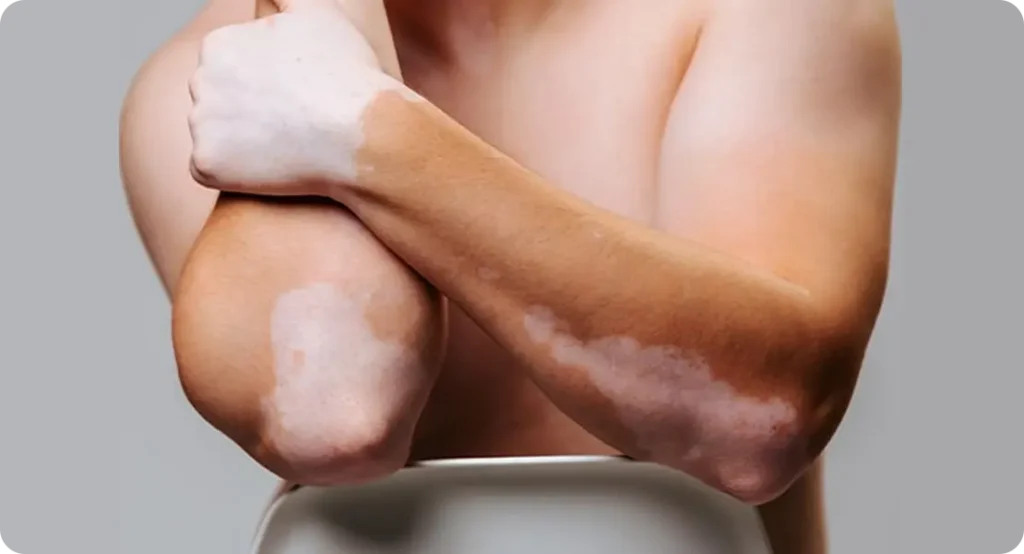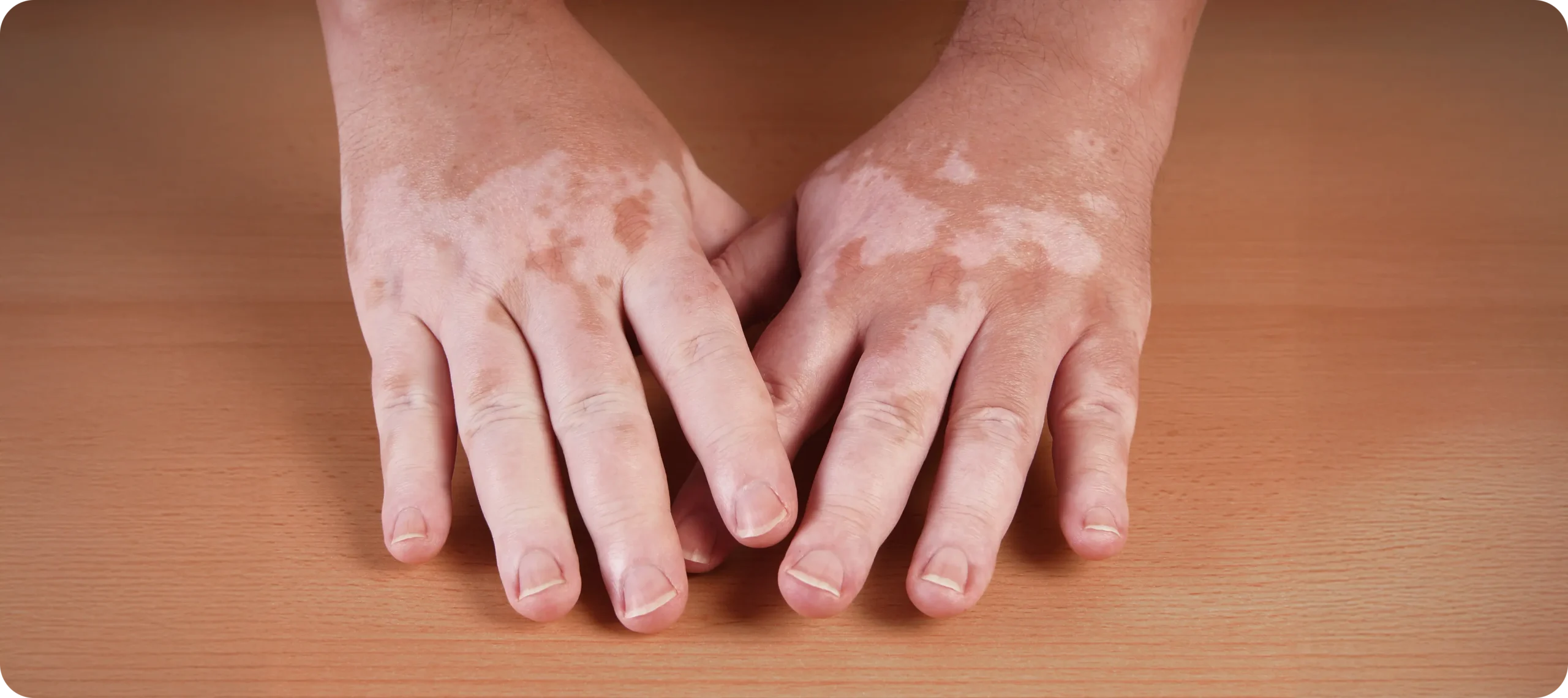Vitiligo, a chronic skin condition marked by the loss of pigment-producing cells called melanocytes, continues to challenge patients and clinicians alike. Affecting roughly 1–2% of the global population, vitiligo is more than just a cosmetic concern—it can significantly impact self-esteem, mental health, and social well-being. The unpredictable progression and lack of a universally effective treatment make it one of the most complex dermatological disorders to manage.
Fortunately, the past few years have ushered in a wave of scientific breakthroughs, and 2025 marks a turning point in how vitiligo is studied and treated. From targeted immunotherapies like Janus kinase (JAK) inhibitors to advanced cellular therapies such as melanocyte transplantation and stem cell-based strategies, the treatment landscape is rapidly expanding. These novel therapies not only aim to halt disease progression but also promote repigmentation with greater precision and fewer side effects than older methods.
This article delves into the most promising developments in vitiligo treatment as of 2025. We’ll explore the mechanisms behind emerging therapies, review recent clinical trial outcomes, and discuss how these innovations could soon redefine the standard of care. Whether you are a clinician, researcher, or someone personally affected by vitiligo, this guide offers a comprehensive overview of where the science is headed and what to expect in the near future.
1. Understanding the Autoimmune Nature of Vitiligo
Vitiligo is widely considered to be an autoimmune condition, where the body’s own immune system attacks melanocytes. This leads to the characteristic depigmented patches on the skin. Understanding this underlying mechanism has guided the development of targeted therapies.
In recent years, researchers have identified specific T-cell subtypes responsible for triggering melanocyte destruction. Cytokines such as IFN-γ and TNF-α have also been linked to the disease’s progression. Blocking these immune responses has become a key goal in vitiligo treatment.
These findings have changed the way clinicians assess and manage vitiligo. Rather than only attempting to stimulate pigment, the focus now includes modulating the immune response. This dual approach is proving more effective in preventing relapse.
2. Janus Kinase (JAK) Inhibitors: Leading the Revolution
JAK inhibitors have emerged as one of the most promising new treatments for vitiligo. These drugs work by interrupting the inflammatory signalling pathways responsible for melanocyte destruction. Tofacitinib and ruxolitinib are among the most studied agents in this class.
In clinical trials, JAK inhibitors have demonstrated substantial repigmentation, particularly on the face and neck. Patients report improvements as early as 8 to 12 weeks after starting treatment. These drugs can be taken orally or applied topically, depending on the formulation.
The safety profile of JAK inhibitors is still under close observation. Long-term studies are underway to assess side effects in paediatric and adult patients. Nonetheless, their success represents a major step forward in vitiligo care.
3. Advancements in Topical Immunomodulators

Topical immunomodulators have been used for years, but newer versions offer better absorption and reduced irritation. Tacrolimus and pimecrolimus remain foundational treatments. In 2025, enhanced delivery systems have improved their efficacy.
Nano-formulations and lipid-based carriers are allowing for deeper skin penetration. This means active ingredients reach the basal layer where melanocytes reside. Such improvements increase the chances of successful repigmentation.
Combination therapies are also being explored, pairing topicals with phototherapy or systemic agents. These strategies are especially useful for children or patients with limited vitiligo. Continued innovation is improving outcomes with fewer risks.
4. Narrowband UVB and Light-Based Therapies
Phototherapy remains a cornerstone of vitiligo treatment, especially for widespread or stubborn cases. Narrowband UVB (NB-UVB) has shown high success rates in stimulating repigmentation. It works by both suppressing the autoimmune response and activating melanocytes.
In 2025, advancements in home phototherapy units are making treatment more accessible. Patients can now undergo light therapy safely at home with dermatologist oversight. This improves adherence and convenience for families.
Excimer lasers and targeted phototherapy are being used for smaller patches. These techniques deliver precise UVB energy with minimal exposure to surrounding skin. They are especially useful for facial lesions.
5. Melanocyte Transplantation Techniques
Melanocyte transplantation is a cellular approach where healthy pigment cells are transferred to vitiligo-affected areas. In 2025, this method has become more refined and accessible. It is especially used in segmental vitiligo or stable cases.
There are several types of transplants, including suction blister epidermal grafts and non-cultured epidermal cell suspensions. Each has its own benefits and success rates depending on the case. Recovery times and cosmetic outcomes have improved significantly.
Ongoing research is looking at combining cell transplantation with JAK inhibitors or phototherapy. This multi-modal approach may maximise results and reduce the risk of recurrence. Melanocyte restoration is becoming a key part of advanced vitiligo care.
6. Stem Cell-Based Approaches
Stem cell therapies are gaining attention for their potential to regenerate melanocytes. Mesenchymal stem cells and induced pluripotent stem cells (iPSCs) are being investigated for their ability to restore pigment. These cells can modulate immune responses and support tissue repair.
In early-phase trials, stem cell injections into vitiligo lesions have shown encouraging signs of repigmentation. These therapies are often combined with other treatments like light therapy. Stem cells may also help recondition the skin environment to support melanocyte survival.
Although still experimental, the progress in 2025 is significant. More clinical trials are underway across Europe and Asia. In time, stem cell treatments could become a routine part of personalised vitiligo therapy.
7. Combination Therapies for Greater Effectiveness
The complexity of vitiligo has led researchers to test combination therapies that attack the disease from multiple angles. A common approach is combining JAK inhibitors with narrowband UVB light. This dual method appears to accelerate repigmentation and improve long-term results.
Other combinations include topical corticosteroids paired with calcineurin inhibitors. By reducing inflammation and stabilising the immune response, these pairings enhance the efficacy of pigment-stimulating treatments. Patients often experience better coverage and sustained benefits.
Ongoing studies in 2025 are focusing on identifying the most synergistic treatment blends. Personalised regimens are becoming more common as clinicians tailor combinations based on the severity, age, and progression of the condition. This marks a significant shift toward precision dermatology.
8. Advances in Genetic and Epigenetic Research

Understanding the genetic basis of vitiligo is helping researchers identify why some individuals are more susceptible. Specific gene variants, such as those related to NLRP1 and TYR, have been linked to the disease. These discoveries are paving the way for gene-based interventions.
Epigenetics is also emerging as a key area of study. Researchers are now examining how environmental factors like stress, diet, and pollution can influence gene expression in vitiligo patients. This helps explain why identical twins can have differing disease patterns.
These insights may soon allow for early detection and personalised risk assessments. Genetic screening and epigenetic therapies could be the next frontier in vitiligo care. The implications are vast for both prevention and treatment.
9. Role of Diet and Microbiome in Skin Health
Recent studies suggest that gut health and dietary choices may influence skin pigmentation. The gut-skin axis highlights how imbalances in the microbiome can trigger inflammation, potentially worsening autoimmune skin diseases like vitiligo. Probiotic supplements are now under study for their potential to modulate immune responses.
Nutritional interventions such as antioxidant-rich diets, vitamin D, and B12 supplementation have shown modest benefits. These dietary adjustments may support repigmentation when combined with other treatments. Patient awareness of these options is increasing in 2025.
The role of nutrition is still supplementary, but its importance is gaining traction. Dermatologists are beginning to include dietary assessments as part of holistic vitiligo care. Integrative strategies like this are shaping the future of treatment.
10. Psychological Support and Quality of Life Improvements
Vitiligo’s emotional and psychological toll can be profound, especially in children and adolescents. Anxiety, depression, and social isolation are common among sufferers. Psychological support is now recognised as a core component of comprehensive treatment.
In 2025, more clinics are offering therapy, counselling, and support groups as part of vitiligo management plans. Cognitive behavioural therapy (CBT) and mindfulness techniques are helping patients cope with visible changes and societal pressures. These interventions improve quality of life alongside physical treatments.
Education and social acceptance campaigns are also making a difference. Increasing public awareness reduces stigma and encourages early diagnosis. Emotional well-being is finally receiving the attention it deserves in dermatological care.
11. Innovations in Drug Delivery Systems
One of the key focuses in 2025 is improving how treatments are delivered to vitiligo-affected skin. Researchers are developing advanced delivery mechanisms such as microneedle patches and transdermal gels. These technologies enhance the absorption of active ingredients and minimise systemic exposure.
Microneedle arrays can deliver drugs directly to the deeper skin layers without causing pain or significant discomfort. This is especially helpful in children or patients with sensitive skin. Transdermal patches containing JAK inhibitors or tacrolimus are already undergoing trials.
These innovations aim to increase convenience and compliance. Patients benefit from fewer side effects, better skin penetration, and easier application. Drug delivery breakthroughs are helping close the gap between research and real-world treatment success.
12. Artificial Intelligence in Vitiligo Diagnosis and Monitoring
Artificial Intelligence (AI) is transforming dermatology, and vitiligo care is no exception. AI tools are now being used to assist in diagnosis, track disease progression, and predict treatment response. Mobile apps and teledermatology platforms are incorporating AI-based skin analysis.
Advanced imaging algorithms can distinguish between vitiligo and other hypopigmented conditions. They also monitor changes over time, helping dermatologists fine-tune therapy plans. AI is particularly helpful for remote monitoring and managing patients who lack easy access to specialists.
As the technology matures, AI may help stratify patients based on disease stage and likely response to therapies. This leads to more personalised care. Integrating AI into practice is becoming standard in cutting-edge dermatology clinics.
13. Focus on Paediatric Vitiligo

Paediatric vitiligo presents unique challenges due to the patient’s age, emotional development, and skin sensitivity. In 2025, specific protocols for treating children are being refined. These include gentler formulations, behavioural therapy support, and school-based education initiatives.
JAK inhibitors and phototherapy are cautiously used in children, with paediatric trials confirming safety and efficacy in select populations. Topical treatments remain the first line of defence. Clinicians also focus on early intervention to prevent psychological distress.
Child-focused treatment centres are gaining popularity. These centres combine dermatology with paediatric counselling to offer a holistic care experience. Tailored care is now widely recognised as essential for long-term success in young patients.
14. Cosmetic Camouflage and Skin Tone Matching
While repigmentation therapies remain the focus, cosmetic camouflage continues to be a vital support tool. Newer pigment-matching formulations are long-lasting and waterproof. These are designed to match a variety of skin tones with greater accuracy.
High-quality cosmetic camouflage improves confidence and social engagement. Products are now infused with skin-soothing ingredients to avoid irritation. Some are also designed to blend with repigmenting areas, adapting as skin colour changes.
In 2025, more dermatologists are training patients in camouflage techniques as part of the management plan. Workshops and online tutorials are widely available. The result is a more empowered patient community with better coping strategies.
15. Social Media and Patient Advocacy Movements
Vitiligo visibility has increased significantly through social media platforms. Influencers and advocacy groups are using Instagram, TikTok, and YouTube to raise awareness and share success stories. This has helped reduce stigma and foster community support.
Campaigns like #VitiligoIsBeautiful have empowered patients to embrace their unique appearance. Many dermatology clinics now collaborate with patient advocates to improve communication and outreach. This shift is making vitiligo care more inclusive and patient-centred.
These platforms also serve as educational tools. Patients share treatment experiences and connect with research updates in real time. In 2025, digital communities are a powerful force in shaping the future of vitiligo awareness and treatment.
16. Clinical Trials Driving the Future of Treatment
Clinical research in 2025 is focused on testing both new therapies and combinations of existing treatments. Numerous trials are exploring the safety and efficacy of JAK inhibitors in different formulations and demographic groups. These studies are laying the groundwork for regulatory approvals and new treatment protocols.
Randomised controlled trials (RCTs) remain the gold standard for vitiligo research. Trials now also incorporate quality-of-life metrics, giving a holistic view of how therapies affect daily living. Some multicentre studies are looking at long-term stability of repigmentation.
Participation in trials gives patients early access to cutting-edge treatments. It also provides essential data for improving medical understanding. Ongoing research efforts are crucial to continually refining the standard of care.
17. Phototherapy Enhancements Using LED and Laser
Traditional UVB light therapy is being enhanced with newer technologies such as LED and low-level laser therapy (LLLT). These options offer more targeted treatment with reduced exposure risks. They also improve comfort and reduce treatment times.
LED-based units emit consistent light intensity and allow for customisable wavelengths. This makes them suitable for sensitive areas like the face or neck. Patients undergoing these therapies report fewer side effects and faster results.
As devices become more compact and user-friendly, home-based phototherapy is gaining traction. Dermatologists are prescribing specific regimens tailored to skin type and vitiligo extent. This personalised care is making light therapy more effective and accessible.
18. Integrating Psychodermatology in Treatment Plans

Psychodermatology combines dermatological care with psychological support. It recognises that conditions like vitiligo have deep emotional and mental impacts. In 2025, more clinics are adopting this integrated approach.
Patients receive counselling alongside their medical treatment, helping them navigate body image issues, stress, and social anxiety. This support can also improve treatment adherence and outcomes. Some centres even offer group therapy tailored to dermatology patients.
The field is also influencing how medical professionals are trained. Dermatologists are now being educated in basic psychological care principles. This holistic understanding is enhancing patient trust and satisfaction.
Final Thoughts: Embracing a New Era of Vitiligo Care
Vitiligo management has entered a transformative era, where science and compassion work hand in hand. From the development of JAK inhibitors and stem cell innovations to the integration of psychological support and AI, 2025 represents a milestone in dermatological progress. Patients now have access to safer, more effective, and more individualised treatments than ever before.
This advancement reflects not only improved technology but also a broader understanding of what it means to live with vitiligo. As society becomes more accepting and research continues to evolve, the stigma surrounding this condition is gradually fading. The focus has shifted from simply managing symptoms to empowering patients with tools for long-term well-being.
If your child is showing signs of vitiligo or has already been diagnosed, getting the right treatment and support can make a significant difference. At our vitiligo clinic in London, you can book a consultation with one of our expert dermatologists to receive a tailored treatment plan designed specifically for your child’s skin. With the right care, guidance, and access to innovative therapies, managing vitiligo and living with confidence is more possible than ever.
References:
- Ezzedine, K., Eleftheriadou, V., Whitton, M. and van Geel, N., 2015. Vitiligo. The Lancet, 386(9988), pp.74-84.
- Rodrigues, M., Ezzedine, K. and Hamzavi, I., 2017. New discoveries in the pathogenesis and classification of vitiligo. Journal of the American Academy of Dermatology, 77(1), pp.1-13
- Bergqvist, C., Ezzedine, K. and Passeron, T., 2020. Vitiligo pathogenesis: an update. Clinical Reviews in Allergy & Immunology, 59(1), pp.1–19.
- Guttman-Yassky, E., Lal, M., Zhang, N., & Noda, S., 2021. JAK inhibitors in dermatology: Progress and promise. JAMA Dermatology, 157(3), pp.301–308.
- Rashighi, M. and Harris, J.E., 2017. Interfering with the IFN: targeting cytokine signaling in vitiligo. J Invest Dermatol, 137(1), pp.18–20. https://doi.org/10.1016/j.jid.2016.08.025 [Accessed 29 May 2025].
